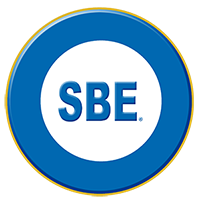SBE’s History is People
The Society of Broadcast Engineers has had great growth since the organization’s founding in 1964. This growth is largely due to the many members who have contributed greatly to the birth, development and subsequent success of the organization. SBE’s Charter Members were those who were there at the beginning, with a positive attitude and a desire to build. Its past presidents each contributed to the SBE’s growth and kept the society on an upward path with their leadership. Those who have held membership over many years and into retirement became Life Members and contribute and provide support in so many ways. A handful of honorary members were recognized for their support of the society or their contributions to the field of broadcasting engineering. An honor role of these members is provided here.
Charter Members | Presidents | Life Members | Honorary Members | Fellow Members
A brief history of the SBE
The society’s roots can be traced back to 1961 when the Institute of Radio Engineers (IRE) and the American Institute of Electrical Engineers (AIEE) passed a joint resolution calling for a “merger or consolidation… into one organization.” The two groups did finally join forces in 1963, forming what is known today as the Institute of Electrical and Electronic Engineers (IEEE). However, the new organization was perceived by some as not addressing the needs of broadcast engineers.
John H. Battison, P.E., CPBE, editor of Broadcast Engineering magazine at the time, was one of those people. He wrote an editorial that appeared in his magazine in 1961 that suggested the idea of a new organization just for broadcast engineers. Battison’s continued efforts sparked interest across the country. He published a membership application in the April 1963 issue of the magazine and the response was encouraging. With help from family members, Battison mailed membership invitations to almost 5,000 radio and TV engineers in the United States and Canada.
Finally, on April 5, 1964, an organizational meeting was held during the National Association of Broadcasters convention at the Conrad Hilton Hotel in Chicago. Approximately 100 interested broadcast engineers attended. The group formed an organization devoted solely to the needs and interests of broadcast engineers, with Battison as its first president. They at first settled on the name, “Institute of Broadcast Engineers (IBE).” However, because some members feared there might be confusion in the similarity between the names of the IBE and the IBEW (International Brotherhood of Electrical Workers), the name was changed to Society of Broadcast Engineers (SBE) at that very first meeting. SBE now has approximately 5,000 members that can be found in all 50 states, four U.S. territories and in 25 other countries.
With 114 chapters located throughout the United States and Hong Kong, SBE commands a leadership position in the broadcast industry. Local chapters of the SBE provide services and benefits to members through meetings, technical seminars, certification examinations, leadership opportunities, recognition and fellowship.
The SBE’s first chapter was organized in Binghamton, NY, and it is still active today. Today, there are SBE chapters in every major American city and dozens of others as well.
The SBE Program of Certification, was adopted in 1975 and launched in 1977, helping individuals improve their skills and gain recognition for their knowledge and experience through a national testing program. As the industry’s preeminent evaluation service for broadcast engineers, SBE Certification provides important benefits to both members and employers. Those who have earned SBE Certification are proud of their accomplishment, and rightly so.
In recent years, the SBE on a national level has greatly increased its focus on education as keeping up with new technology has become even more important to our members. The society offers several dozen education courses on various topics in tradional in-person settings and via the Internet each year.
The SBE is also known for its involvement in developing in the mid-1970s a nationwide network of more than 200 volunteer frequency coordinators. Through these volunteers, the SBE provides a vital service to stations, networks and other users of broadcast spectrum who need information about auxiliary broadcast frequencies. Through the efforts of society members, this important spectrum is used efficiently, and interference is minimized.
The society continually monitors regulatory issues and frequently files comments with the FCC and other federal and state agencies. In many cases, the SBE is the only organization representing the technical interests of broadcast engineers on regulatory issues.
Throughout its history, the SBE has strived to advance the field of broadcast engineering and the professional development of the broadcast engineer by being in the forefront as changes in technology have taken place. The society will continue to help its members stay on the leading edge of the broadcast industry by providing leadership, information, certification, education and opportunities for recognition.
There have been many members who have played important roles in the 47 years of the society’s growth – too many to name here. With a strong membership that represents the breadth and scope of the broadcast engineering industry, the SBE will surely continue its leadership role in the years to come.

